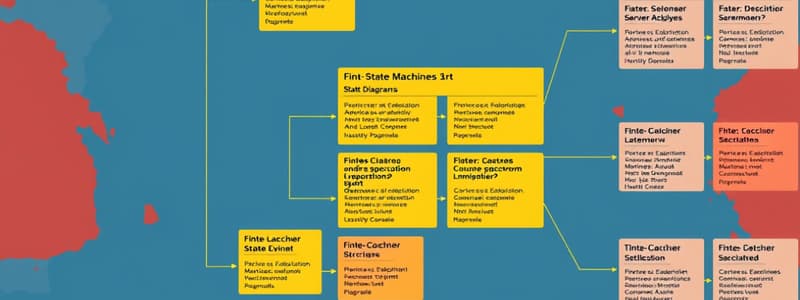Podcast
Questions and Answers
What components are included in a finite-state machine?
What components are included in a finite-state machine?
- A finite set of states, input alphabet, output alphabet, transition function, output function, and an initial state (correct)
- A finite set of states and a deterministic output function
- A series of inputs and a recursive output function
- An initial state and a single transition function
In the context of finite-state machines with output, what does the output function g do?
In the context of finite-state machines with output, what does the output function g do?
- Initiates the machine from the start state
- Generates the output based on state and input pair (correct)
- Determines the next state based on the current state
- Assigns an input character to each state
Which of the following applications can utilize finite-state machines?
Which of the following applications can utilize finite-state machines?
- Recognizing speech and spell checking (correct)
- Calculating complex mathematical equations
- Rendering 3D graphics
- Developing neural networks
What is a directed graph with labeled edges used to represent in finite-state machines?
What is a directed graph with labeled edges used to represent in finite-state machines?
Which of the following best describes the transition function f in a finite-state machine?
Which of the following best describes the transition function f in a finite-state machine?
Study Notes
Finite-State Machines Overview
- Finite-state machines (FSMs) model various machines, especially in computer systems.
- Components of FSM include a finite set of states, a starting state, an input alphabet, and a transition function.
- FSMs are widely utilized for spell checking, grammar checking, searching text, and speech recognition.
Definition of Finite-State Machines with Output
- A finite-state machine M is defined by tuples: M = (S, I, O, f, g, s₀).
- S = finite set of states.
- I = finite input alphabet.
- O = finite output alphabet.
- f = transition function determining next state based on current state and input.
- g = output function producing output based on current state and input.
- s₀ = initial state.
State Table and Diagrams
- State tables depict the transition function and output function.
- State diagrams are directed graphs where:
- Circles represent states.
- Arrows show transitions labeled with input/output pairs.
Input and Output Relationships
- Input strings result in state transitions and produce output strings.
- The output function g can be extended to work with input strings, denoting g(x) = y for input x yielding output y.
Example Outputs from FSMs
- A specific input string, such as 101011, produces an output string, like 001000.
- Each transition through states generates corresponding outputs.
Memory Limitations of FSMs
- FSMs have limited memory due to a finite number of states, which restricts their functionality for complex tasks.
Unit-Delay Machine
- A finite-state machine can be designed to delay an input string by one unit of time.
- This machine utilizes three states to remember the last two inputs, producing an output string that reflects the delayed input.
Error Detection in Strings
- FSMs can be designed to detect transmission errors, such as identifying three consecutive 1s in a message.
- This type involves:
- A start state (s₀) that remembers when the last bit was not a 1.
- Additional states (s₁ and s₂) to track consecutive 1s.
- Inputs of 1 and 0 transition between these states, with outputs responding based on the state of the last three bits.
Studying That Suits You
Use AI to generate personalized quizzes and flashcards to suit your learning preferences.
Related Documents
Description
This quiz focuses on understanding finite-state machines through state diagrams and state tables. Participants will construct state diagrams from given state tables and vice versa. Test your knowledge of these concepts with practical examples and solutions.




